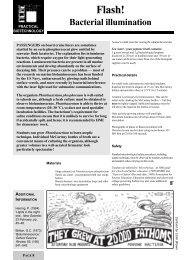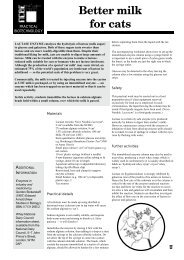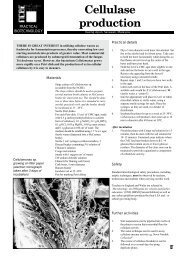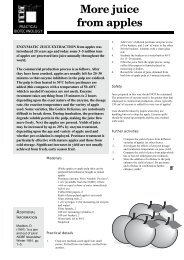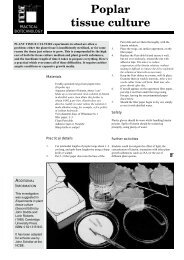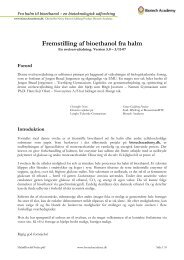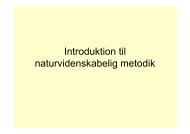Cloned cauliflower - National Centre for Biotechnology Education
Cloned cauliflower - National Centre for Biotechnology Education
Cloned cauliflower - National Centre for Biotechnology Education
You also want an ePaper? Increase the reach of your titles
YUMPU automatically turns print PDFs into web optimized ePapers that Google loves.
PRACTICAL<br />
BIOTECHNOLOGY<br />
<strong>Cloned</strong><br />
<strong>cauliflower</strong><br />
ADAPTED FROM AN ORIGINAL PRACTICAL DEVELOPED BY TONY STORR<br />
PRACTICAL EXPERIENCE of plant tissue culture is called<br />
<strong>for</strong> in many biology and some science syllabuses. The plant most<br />
commonly used <strong>for</strong> such work in schools and colleges is<br />
<strong>cauliflower</strong>. This material is ideal <strong>for</strong> plant tissue culture,<br />
because it is readily available, robust enough to withstand the<br />
rigours of being handled by students and grows rapidly. Growth<br />
can be seen after 10 days and plantlets ready <strong>for</strong> transplantation<br />
are <strong>for</strong>med within 12 weeks.<br />
Materials<br />
For each student or group of students:<br />
Cauliflower curd (the white part)<br />
Sterile distilled water, 100 cm 3<br />
70% ethanol, 50 cm 3<br />
20% Domestos solution (Chlorate I solution with<br />
added detergent), 100 cm 3<br />
Test tubes, each containing 2–3 cm 3 of plant tissue<br />
growth medium as described below, 3<br />
Sterile Petri dish<br />
Metal <strong>for</strong>ceps and scalpel<br />
Non-absorbent cotton wool and aluminium foil<br />
To make 1 litre of the plant tissue growth medium:<br />
Granulated sugar, 20 g<br />
Agar, 10 g<br />
Murashige and Skoog (M&S) medium, 4.7 g<br />
Kinetin stock solution, 25 cm 3<br />
From this point on, quick, aseptic operations are<br />
important to prevent contamination.<br />
4. Rinse the explants in three successive beakers of<br />
sterile distilled water. Use flamed, cooled <strong>for</strong>ceps to<br />
do this — the correct way to flame <strong>for</strong>ceps and other<br />
instruments is to dip them in alcohol, then to pass<br />
them briefly through a flame to ignite the ethanol. As<br />
the ethanol burns off, it heats the surface of the<br />
instruments to 70°C, killing any contaminating<br />
organisms. Do not heat <strong>for</strong>ceps and scalpels until red<br />
hot, and remember to keep ethanol away from<br />
exposed flames.<br />
5. The explants can be left in the final beaker of sterile<br />
water (covered with a Petri dish lid) until required.<br />
6. Take the first tube of growth medium, withdraw the<br />
cotton wool plug, then briefly flame the neck. Use<br />
flamed, cooled <strong>for</strong>ceps to pick up an explant and<br />
quickly drop it into the tube. Return the <strong>for</strong>ceps to the<br />
ethanol beaker. Flame the neck of the tube once more,<br />
then replace the plug.<br />
7. Repeat Step 6 with the two remaining explants and<br />
two fresh tubes of growth medium.<br />
8. The tubes should be kept in a warm, light place.<br />
Growth should be visible within 10 days.<br />
Contamination, if it has occurred, should also be<br />
visible by this time. Failure of anything to grow<br />
usually indicates that the bleach has not been rinsed<br />
from the plant tissue.<br />
Safety<br />
Plastic gloves should be worn when handling kinetin.<br />
Students should wear safety goggles when using bleach<br />
solution.<br />
ADDITIONAL<br />
INFORMATION<br />
Plant tissue<br />
culture by Tony<br />
Storr (1985)<br />
Experimenting<br />
with Industry<br />
No.13, Association<br />
<strong>for</strong> Science<br />
<strong>Education</strong>.<br />
ISBN: 0 86357 031 3.<br />
This excellent and<br />
inexpensive book<br />
has <strong>for</strong> many<br />
years been the<br />
guide to plant<br />
tissue culture<br />
work in schools.<br />
The kinetin stock solution contains 0.1 g kinetin in 1 litre of<br />
distilled water. Kinetin does not readily dissolve in water;<br />
the addition of one or two pellets of sodium hydroxide helps<br />
the dissolution process. Stock solution should be stored in a<br />
’fridge at 4°C.<br />
To prepare the growth medium, dissolve the sugar, M&S<br />
medium and agar in 725 cm 3 distilled water. Mix in the<br />
stock kinetin solution, then dispense into test tubes. About<br />
2–3 cm 3 will be needed per tube. Plug the tubes with nonabsorbent<br />
cotton wool and cap them with aluminium foil.<br />
Autoclave at 121°C <strong>for</strong> 15 minutes in a pressure cooker.<br />
When cool, the tubes may be refrigerated until they are<br />
needed.<br />
M&S medium and kinetin are available from school science<br />
suppliers e.g. Philip Harris Limited.<br />
Practical details<br />
1. Swab the working area with 70% ethanol. Keep the<br />
ethanol away from exposed flames!<br />
2. Cut out a small piece of <strong>cauliflower</strong> curd; roughly the size<br />
of a cherry. Working on a clean Petri dish, divide the curd<br />
into three.<br />
3. Place the pieces (explants) in bleach e.g. Domestos solution<br />
<strong>for</strong> 10 minutes to surface sterilize the tissue.<br />
Ethanol used <strong>for</strong> sterilizing working surfaces should<br />
be kept away from naked flames.<br />
Photograph kindly supplied by students of St. Felix School, Suffolk.
<strong>Cloned</strong><br />
<strong>cauliflower</strong><br />
1. Cut out a small piece of<br />
<strong>cauliflower</strong> curd (the white<br />
part).<br />
Sterile test tube<br />
containing<br />
growth medium<br />
with added kinetin<br />
Sterile cotton<br />
wool plug<br />
2. Cut the curd into three<br />
small pieces (explants) on<br />
a clean Petri dish.<br />
Explant<br />
transferred using<br />
sterile <strong>for</strong>ceps<br />
7. Repeat Step 6 with the<br />
two remaining explants.<br />
Label the tubes with your<br />
name and the date.<br />
3. Drop the<br />
explants into<br />
fresh bleach<br />
solution, and<br />
leave them to<br />
surface sterilize<br />
<strong>for</strong> ten minutes<br />
only.<br />
Leave the explants in<br />
the rinsing water <strong>for</strong> at<br />
least a minute.<br />
5. Rinse the<br />
explants twice<br />
more in the<br />
same way,<br />
each time<br />
making sure<br />
that the<br />
<strong>for</strong>ceps are resterilized.<br />
Foil<br />
cover<br />
foil, placedAluminium 8. Look at the tubes<br />
after ten days, and<br />
again after a <strong>for</strong>tnight.<br />
Chlorate<br />
I<br />
solution<br />
4. After ten minutes, transfer<br />
the explants into some sterile<br />
water. Use flamed, cooled <strong>for</strong>ceps to do this.<br />
6. Aseptically transfer the<br />
explant into a test tube<br />
containing growth medium<br />
with added kinetin.<br />
over the cotton wool,<br />
helps to reduce moisture<br />
loss.<br />
© <strong>National</strong> <strong>Centre</strong> <strong>for</strong> <strong>Biotechnology</strong> <strong>Education</strong>, 1995



